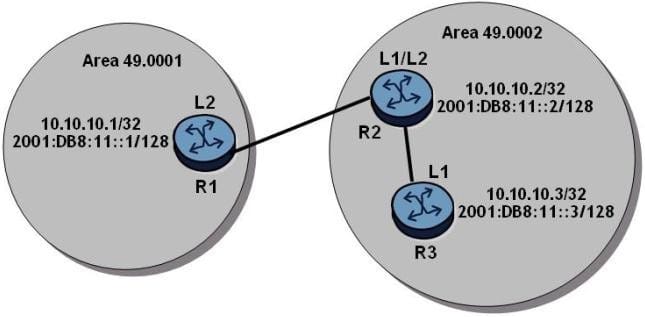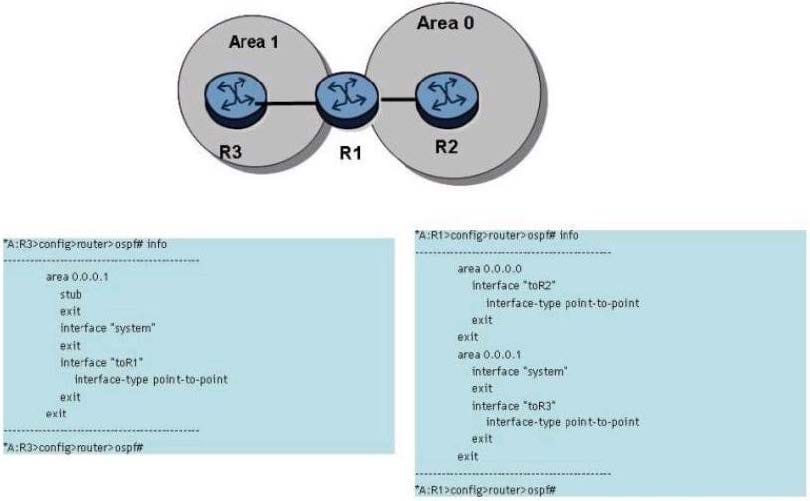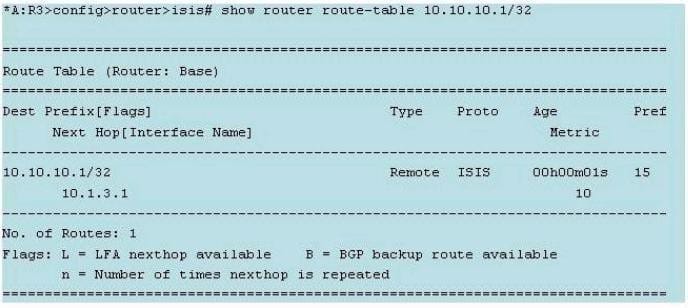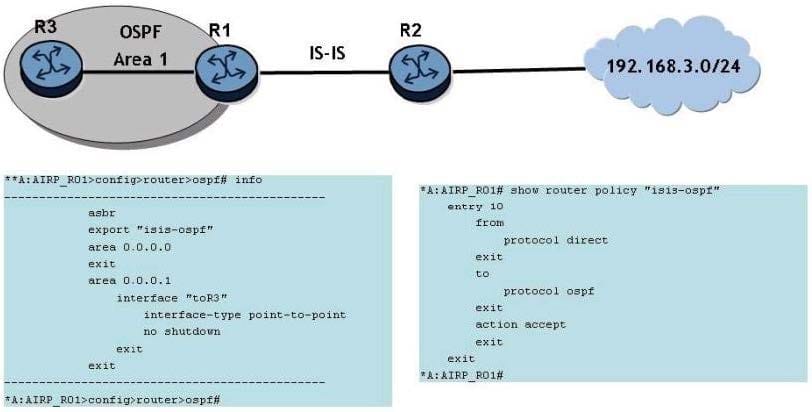Exam Details
Exam Code
:4A0-101Exam Name
:Nokia Interior Routing ProtocolsCertification
:Nokia CertificationsVendor
:NokiaTotal Questions
:315 Q&AsLast Updated
:Apr 08, 2025
Nokia Nokia Certifications 4A0-101 Questions & Answers
-
Question 91:
Click on the exhibit.

The routers have an established IS-IS L2 adjacency on which IPv4 system addresses are exchanged. An operator successfully configures multi-topology IS-IS routing so that the IPv6 system addresses are also exchanged between routers.
After IPv6 has been configured, which of the following is TRUE?
A. Router R2 has two IS-IS adjacencies and two LSPs
B. Router R2 has two IS-IS adjacencies and three LSPs
C. Router R2 has two IS-IS adjacencies and four LSPs
D. Router R2 has three IS-IS adjacencies and three LSPs
E. Router R2 has three IS-IS adjacencies and four LSPs
F. Router R2 has three IS-IS adjacencies and six LSPs
-
Question 92:
Click on the exhibit.

If router R2 re-distributes the IS-IS route 192.168.3.0/24 into OSPF, router R3 will receive two routes to 192.168.3.0/24. Assume that all IS-IS routers are L1/L2 capable and are in the same area.
Which of the following is TRUE?
A. Router R3 will install the OSPF route in its routing table.
B. Router R3 will install the IS-IS route in its routing table
C. Router R3 will install an OSPF route and an IS-IS route in its routing table.
D. There is not enough information to answer the question.
-
Question 93:
Click on the exhibit.

The OSPF adjacency between routers R1 and R3 does not come up. Which of the following is a possible solution to the problem?
A. Stub must be configured on Area 1 of router R1, and removed from Area 1 on router R3.
B. Stub must be configured on Area 1 of router R1 and Area 1 of router R3.
C. Stub must be configured on Area 0 of router R1 and Area 1 of router R3.
D. Area 1 of router R3 should be Area 0, in order to connect via stub to router R1.
-
Question 94:
Which of the following correctly describes an IPV6 header compared to an IPv4 header?
A. The IPv6 header has a header checksum field, header length field and no fragmentation offset field.
B. The IPv6 header has no header checksum field, no header length field and does have a fragmentation offset field.
C. The IPv6 header has a header checksum field, no header length field and no fragmentation offset field.
D. The IPv6 header has no header checksum field, no header length field and no fragmentation offset field.
-
Question 95:
What is the primary purpose of variable length subnet masks (VLSM)?
A. To reduce the size of each routing update.
B. To allow interoperability between routing protocols.
C. To allow different subnet masks for different subnets.
D. To reduce the size of the routing table.
-
Question 96:
Which of the following best describes the function of an OSPF Type 4 LSA?
A. A Type 4 LSA is originated by an ABR to describe a route to an ASBR to routers outside the area.
B. A Type 4 LSA is originated by an ASBR to describe a route to itself to routers outside the area.
C. A Type 4 LSA is originated by an ABR that is connected to a stub area. The LSA is injected into the backbone area to provide routing information.
D. A Type 4 LSA is originated by an ABR that is connected to a stub area. The LSA is injected into the stub area to provide routing information.
-
Question 97:
Which of the following concerning OSPFv3 is TRUE?
A. OSPFv3 uses MD5 Authentication.
B. Router LSAs carry IPv6 prefix information.
C. NSSA is supported in OSPFv3.
D. OSPFv3 uses a 64-bit router ID.
-
Question 98:
Which field of an IPv6 header indicates an upper layer protocol carried in the packet?
A. Next Header
B. Traffic Class
C. Flow Label
D. Payload Length
E. Options
-
Question 99:
Click on the exhibit.

The operator of an IS-IS network wishes to have link metrics dynamically calculated in the same manner as OSPF. The router with system address 10.10.10.1 is one hop away on a 1 Gbps link Which of the following is correct?
A. The router is correctly configured.
B. A reference-bandwidth is not configured on the router.
C. A reference-bandwidth is configured on the router but wide-metrics is not.
D. The interface metric must be manually configured to 100.
-
Question 100:
Click on the exhibit.

Router R1 learns the network 192.168.3.0/24 from IS-IS. Given the OSPF configuration shown, why isn't the 192.168.3.0/24 route in router R3's route table?
A. The route policy should be applied as an import policy.
B. The route policy should say "from protocol isis" instead of "from protocol direct".
C. The ASBR configuration should be removed.
D. The interface between routers R1 and R3 must be in OSPF area 0.
Related Exams:
4A0-100
Nokia IP Networks and Services Fundamentals4A0-101
Nokia Interior Routing Protocols4A0-102
Nokia Border Gateway Protocol for Internet Routing4A0-103
Nokia Multiprotocol Label Switching4A0-104
Nokia Services Architecture4A0-105
Nokia Virtual Private LAN Services4A0-106
Nokia Virtual Private Routed Networks4A0-107
Nokia Quality of Service4A0-108
Nokia Multicast Protocols4A0-109
Alcatel-Lucent Triple Play Services
Tips on How to Prepare for the Exams
Nowadays, the certification exams become more and more important and required by more and more enterprises when applying for a job. But how to prepare for the exam effectively? How to prepare for the exam in a short time with less efforts? How to get a ideal result and how to find the most reliable resources? Here on Vcedump.com, you will find all the answers. Vcedump.com provide not only Nokia exam questions, answers and explanations but also complete assistance on your exam preparation and certification application. If you are confused on your 4A0-101 exam preparations and Nokia certification application, do not hesitate to visit our Vcedump.com to find your solutions here.